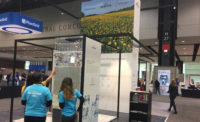Flooring Shows Its Leadership at Greenbuild










Whether it came from the flooring and sponsorship of the Greenbuild LivingHome to being included in what was called the world’s first “Net Zero Zone” to the fact the chairman of the U.S. Green Building Council (USGBC), the organization that started Greenbuild more than a dozen years ago and is the creator of LEED, the most widely used green rating system in the world, comes from a carpet company, the industry showed no signs of taking a back seat in helping to make the world a more sustainable place.
In saying there is still much to be done and learned when it comes to getting industry and people in general to understand the impacts they are making on the world’s environment over the long term, Steve Bradfield, director of sales and marketing, environmental certification services for the third-party certifying firm SCS Global Services, noted, “The flooring industry as a whole is still showing it is a leader in this area with the work it is doing to reduce its overall footprint.”
Helping to lead that charge is Interface, which continues to drive the message started by its late founder Ray Anderson about being a net-zero company and industry.
George Bandy Jr., the company’s vice president of sustainability and USGBC’s chairman, said while it is still “vitally” important to talk about what is in a product and how it is made, and to be transparent about it through any number of third-party certifications that include what many refer to alphabet soup, such as environmental product declarations (EPDs), health product declarations (HPDs) and so on, “the discussion needs to go beyond that to how a product is used and how it affects the overall environment in which it is being used.”
His point being, yes, one should be aware of a product’s ingredients, but unlike food, which is ingested, building products such as flooring is not, so one needs to take a broader look at the products and what their place/function is when installed.
John Wells, Interface’s president and CEO, added that is why the company continues to showcase its message of biophilic design, which is the idea of “our relationship with nature and integrating it into our everyday lives.”
Bandy pointed out how in nature “nothing is flat. There is no perfectly smooth surface, so why do we make our floors so one-dimensional?” He noted this holds true for both soft and hard surface products. “Our feet are made so they can walk on uneven surfaces and we need to create that ability to mimic how the world exists in our indoor, man-made environments.”
So, while the company continued to showcase its partnerships with Aquafil and communities in the Philippines to take used fishing nets, which are made of nylon 6,6 and recycle them back to fiber and into new carpets as an example, the products on its exhibit floor and being shown in the booth featured multiple heights and carvings that made the product more like walking on the earth rather than just a smooth soft surface. Wells noted the fishing nets program has been so successful the company is getting requests from around the world and is working to expand the program to other countries and villages.
Dee Dee Brickner, marketing coordinator for Roppe, agreed with Bandy about broadening the discussion about how the product is used and how it affects that environment.
In showcasing its new Health and Learning collection, which is a coordinated line of vinyl and rubber flooring, she said people have become so engrossed in the specific details of a product they are missing the bigger picture, which is leading to a lot of misperceptions about various products.
Rubber is a prime example, as is vinyl for that matter, as many attendees and green activists have the wrong ideas about these products due to some of their ingredients. “Once it is encapsulated, which it is in flooring, there is no danger to the public. Instead, you now have a product that we can take back and recycle but, more importantly, one that is long-lasting and doesn’t need harsh chemicals to clean. The big picture is these are sustainable products that can add both beauty and function to a space.”
Shaw Industries was again making itself known as a leader in the area of sustainability as its recyclable carpet not only adorned the aisles of the convention center, the company was a Gold sponsor of the LivingHome which was constructed in the exhibition hall so attendees could tour it.
The 1,550 square foot, three-bedroom, two-bath modular home meets LEED v4 Platinum requirements and showcases how exceptional sustainability, high-performance products and healthy living practices can be combined with beauty and function to create an affordable house.
The home was built so that it could be moved to New Orleans’ Lower 9th Ward as part of Brad Pitt’s Make It Right Foundation, which is constructing 150 homes in one of the areas most ravished by Hurricane Katrina in 2005. Shaw was already a major supporter of the Foundation having pledged to donate all the flooring for the 150 homes so it was only natural for its products—from carpet that was bound into rugs to its Cradle to Cradle certified Epic hardwood to porcelain tile—to be the featured floors in the LivingHome, which was open for attendees to view during the show and consistently had a line of people waiting to go inside and tour the structure.
Paul Murray, Shaw’s vice president of sustainability, said the company remains committed to helping the Make It Right Foundation meet its goal and is “honored to be a part of such a noble cause. “These homes are not just the ultimate in sustainability, they show that your house can be both a beautiful, comfortable place to live and one that is friendly to the environment.”
Warren Nesbitt, senior vice-president of residential construction programs for Hanley Wood, which operates Greenbuild, said, “Sustainability, durability, technology and wellness are the cornerstones of the Greenbuild LivingHome. It will set the agenda for sustainable housing for years to come.”
In addition to the LivingHome, Wanda Dunaway, Shaw’s director of education and government markets, said the company’s exhibit space was highlighting its Cut & Compose collection in which the mill is donating a portion of sales proceeds to USGBC’s Center for Green Schools. “It’s part of our corporate culture to not only help, but help in ways that affect the sustainability of peoples lives, and what better place to do it than with our children—and teachers—because it’s been proven that healthy environments create better learning environments.”
Rachel Gutter, director of the Center for Green Schools, said the partnership with Shaw is part of the Center’s Green Apple Initiative, which “wants to send a message to the world that where our children learn matters and it should be done in a place that is healthy, safe and efficient.” She pointed out the partnership with Shaw is important because “as you know, carpet has the ability to improve everything from indoor air quality to acoustics.”
At the Net Zero Zone, Step Warmfloor was one of 11 companies showing how spaces—and products—can be fully powered by an on-site microgrid, including alternate energy generation, storage and distribution.
Monica Irgens, Step Warmfloor’s president, said the concept is to show attendees that “we can be powered by DC without having to waste energy converting it to AC.”
In addition to the companies exhibiting in the 1,500-sq.-ft. Net Zero Zone, there was a networking lounge that had various educational presentations on the subject as well as an outdoor demonstration of typical on-site solar electricity generation that is connected directly to in-building hybrid microgrid storage and distribution equipment adjacent to the networking lounge.
Lindsay Roberts, show director, noted the Net Zero Zone, which was done in partnership with EMerge Alliance, “sends a strong message to the entire green building movement that hybrid power in buildings is both possible and practical.”
Reclaimed wood was also a hot item among those seeking flooring as the products are not only highly sustainable from a variety of standpoints, the rustic, distressed look continues to be a major trend—even in commercial setting as many national retailers and other companies are creating all or parts of their indoor spaces to have that rustic lodge feel.
Jered Slusser, Northeast sales manager for Pioneer Millworks, and the rest of his team was busy explaining to visitors where and how the company gets its wood, which it then turns into both floors and walls depending on the species. One of the collections displayed was FSC-certified teak products that are rescued from dilapidated Indonesian structures.
“We’re one of the largest companies of reclaimed wood,” he said, “and have resources worldwide to ensure our products are not only certified sustainable but both durable and beautiful—something the A&D community desires.”
Looking for a reprint of this article?
From high-res PDFs to custom plaques, order your copy today!















